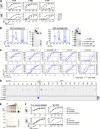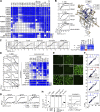Epitope convergence of broadly HIV-1 neutralizing IgA and IgG antibody lineages in a viremic controller
- PMID: 35230385
- PMCID: PMC8932546
- DOI: 10.1084/jem.20212045
Epitope convergence of broadly HIV-1 neutralizing IgA and IgG antibody lineages in a viremic controller
Abstract
Decrypting the B cell ontogeny of HIV-1 broadly neutralizing antibodies (bNAbs) is paramount for vaccine design. Here, we characterized IgA and IgG bNAbs of three distinct B cell lineages in a viremic controller, two of which comprised only IgG+ or IgA+ blood memory B cells; the third combined both IgG and IgA clonal variants. 7-269 bNAb in the IgA-only lineage displayed the highest neutralizing capacity despite limited somatic mutation, and delayed viral rebound in humanized mice. bNAbs in all three lineages targeted the N332 glycan supersite. The 2.8-Å resolution cryo-EM structure of 7-269-BG505 SOSIP.664 complex showed a similar pose as 2G12, on an epitope mainly composed of sugar residues comprising the N332 and N295 glycans. Binding and cryo-EM structural analyses showed that antibodies from the two other lineages interact mostly with glycans N332 and N386. Hence, multiple B cell lineages of IgG and IgA bNAbs focused on a unique HIV-1 site of vulnerability can codevelop in HIV-1 viremic controllers.
© 2022 Lorin et al.
Conflict of interest statement
Disclosures: F.A. Rey is a board member of EureKARE and MELETIUS Therapeutics. No other disclosures were reported.
Figures










References
-
- Anthony, C., York T., Bekker V., Matten D., Selhorst P., Ferreria R.C., Garrett N.J., Karim S.S.A., Morris L., Wood N.T., et al. . 2017. Cooperation between strain-specific and broadly neutralizing responses limited viral escape and prolonged the exposure of the broadly neutralizing epitope. J. Virol. 91:e00828-17. 10.1128/jvi.00828-17 - DOI - PMC - PubMed
-
- Astronomo, R.D., Santra S., Ballweber-Fleming L., Westerberg K.G., Mach L., Hensley-McBain T., Sutherland L., Mildenberg B., Morton G., Yates N.L., et al. . 2016. Neutralization takes precedence over IgG or IgA isotype-related functions in mucosal HIV-1 antibody-mediated protection. EBioMed. 14:97–111. 10.1016/j.ebiom.2016.11.024 - DOI - PMC - PubMed
-
- Barnes, C.O., Gristick H.B., Freund N.T., Escolano A., Lyubimov A.Y., Hartweger H., West A.P., Cohen A.E., Nussenzweig M.C., and Bjorkman P.J.. 2018. Structural characterization of a highly-potent V3-glycan broadly neutralizing antibody bound to natively-glycosylated HIV-1 envelope. Nat. Comm. 9:1251. 10.1038/s41467-018-03632-y - DOI - PMC - PubMed
-
- Behrens, A.J., Vasiljevic S., Pritchard L.K., Harvey D.J., Andev R.S., Krumm S.A., Struwe W.B., Cupo A., Kumar A., Zitzmann N., et al. . 2016. Composition and antigenic effects of individual glycan sites of a trimeric HIV-1 envelope glycoprotein. Cell Rep. 14:2695–2706. 10.1016/j.celrep.2016.02.058 - DOI - PMC - PubMed
Publication types
MeSH terms
Substances
Grants and funding
LinkOut - more resources
Full Text Sources
Other Literature Sources
Medical
Molecular Biology Databases
Miscellaneous

